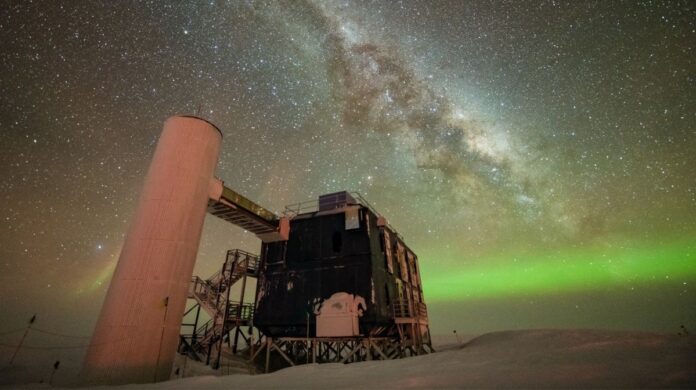Astronomers have detected high-energy neutrinos coming from within our Milky Way galaxy, potentially opening up an exciting new window of research, a new study reports.
Neutrinos are extraordinarily difficult to spot, as they rarely collide with atoms. A light-year’s worth of lead would stop only about half of the neutrinos flying through it (which explains why neutrinos have been dubbed “ghost particles”).
Neutrinos are created from radioactive decay, such as in nuclear reactors, or when extraordinarily high-energy particles strike atoms. The friskiest types feature energies millions to billions of times higher than those produced by the fusion reactions that power stars.
Related: ‘Neutrino factories’ could hold the solution to the cosmic ray mystery
High-energy neutrinos are known to originate from galaxies beyond the Milky Way. But researchers have long suspected that our own galaxy is a source as well. For example, when cosmic rays — atomic nuclei moving at nearly the speed of light — strike dust and gas, they generate both gamma rays and high-energy neutrinos. Previous research has detected gamma rays from the Milky Way’s plane, so scientists have expected high-energy neutrinos from there as well.
There have been hints of such emission, but confirmation has proven elusive to date. The new study took another look, using the IceCube Neutrino Observatory at the Amundsen-Scott South Pole Station. IceCube is embedded within a gigaton (1 billion tons) of ice, making it the first gigaton neutrino detector ever built.
IceCube encompasses 0.24 cubic miles (1 cubic kilometer) of Antarctic ice holding more than 5,000 light sensors. These devices watch for the unique flashes of light that result from the rare instances in which neutrinos do smash into atoms.
The research team focused on the plane of the Milky Way, the dense region of the galaxy that lies along the Milky Way’s equator. They studied 10 years of IceCube data, analyzing 60,000 neutrinos — 30 times more than prior neutrino scans of the galactic plane had looked at.
This was even more difficult than it sounds, because the background of neutrinos produced by cosmic ray collisions with molecules in Earth’s atmosphere clouds efforts to single out neutrinos from farther away.
To overcome this challenge, the researchers used artificial intelligence technology to analyze the IceCube data. This helped weed out atmospheric neutrinos, whose production tends to generate other particles that the observatory can detect as well.
This work identified high-energy neutrinos that likely came from the Milky Way’s galactic plane.
“This observation of high-energy neutrinos opens up an entirely new window to study the properties of our host galaxy,” study co-author Mirco Hüennefeld, an astroparticle physicist at TU Dortmund University in Germany, told Space.com.
“I think it’s exciting to see the young field of neutrino astronomy develop with such an increasing pace,” Hüennefeld added. “It took decades to envision a neutrino telescope such as IceCube, and just in the last few years, we saw an accumulation of exciting observations, including the first evidence of extragalactic sources. Now, with these results, we have achieved a new milestone in neutrino astronomy.”
Although the findings suggest that the newfound neutrinos come from our galaxy, IceCube currently is not sensitive enough to pinpoint their sources. They may emerge in a diffuse manner, or a significant number of them might come from specific points in the sky, Hüennefeld said.
“What’s intriguing about these findings is that, contrary to photons, the galactic neutrino emission is outshined by the extragalactic neutrino flux,” Hüennefeld said.
In the coming years, IceCube will get detector upgrades “that will further enhance its sensitivity, allowing us to obtain a clearer picture of the Milky Way in neutrinos in the near future,” Hüennefeld said. “Answering these questions will have implications on our understanding of cosmic rays and their origin, and also in general on the inferred properties of our host galaxy.”
The scientists detailed their findings online Thursday (June 29) in the journal Science.

